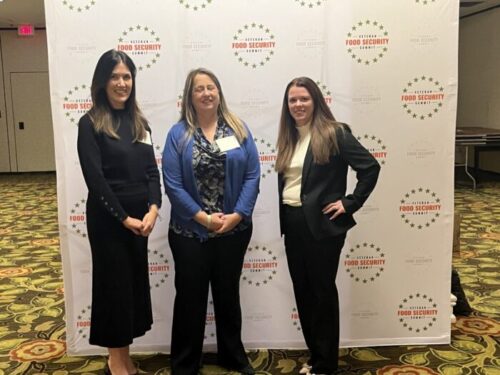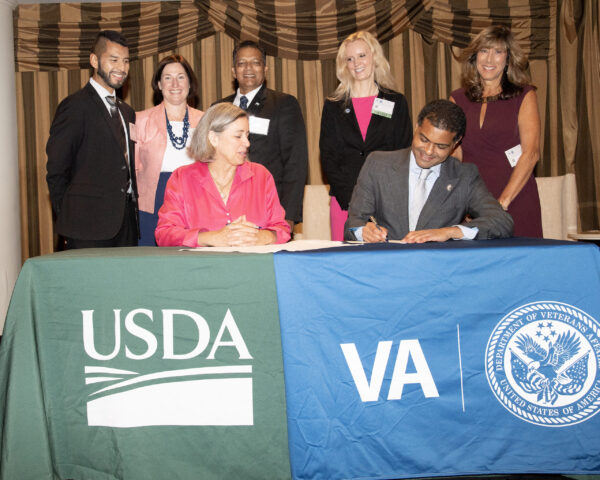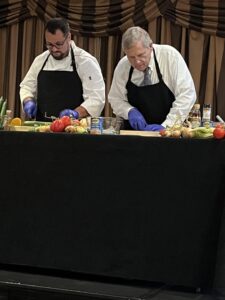November 9, 2023
Veterans Day provides a prime opportunity to not only reflect on the unconscionable rates of food insecurity among veterans, but also to highlight efforts to ensure no veteran goes hungry.
About 7.5 percent of all veterans — nearly 1.4 million — are food insecure.[1] According to a 2021 U.S. Department of Agriculture (USDA) Economic Research Service report, from 2015 to 2019, about 11.1 percent of working-age veterans (ages 18—64) lived in food-insecure households.[2] This rate for working-age veterans was 7.4 percent higher than that of nonveterans.[3]
Certain groups of veterans face disproportionately high rates of food insecurity driven by systemic discrimination. A 2021 study found that veterans were more likely to screen positive for food insecurity at Veterans Health Administration (VHA) visits if they were women, Black, Latinx, non-married or partnered, veterans with low incomes without VA disability-related compensation, as well as if they experienced housing instability or had military sexual trauma. [4]
Food insecurity fuels some of the most chronic and costly health problems across the U.S., including hypertension, coronary artery disease, hepatitis, stroke, cancer, asthma, diabetes, arthritis, chronic obstructive pulmonary disease, and kidney disease.[5] A recent longitudinal study revealed that veterans with food insecurity had nearly four times higher suicidal ideation one year later compared to veterans not reporting food insecurity (39 percent compared to 10 percent).[6]
Given the breadth of food insecurity among veterans and its deep harms to their health, multiple efforts are underway to address food insecurity and connect veterans to the Supplemental Nutrition Assistance Program (SNAP) and other nutrition resources. Of note, The 2022 White House National Strategy on Hunger, Nutrition, and Health instructed the Department of Veterans Affairs (VA) to:
1.Connect eligible veterans with information and SNAP enrollment assistance through VA’s Transition Assistance Program and screening at VA Medical Centers and clinics.
This strategy recognizes the importance of connecting veterans to SNAP, widely considered our nation’s first defense against hunger. By providing benefits to purchase food, SNAP is vital to supporting the nutrition, health, and well-being of military veterans. About 1.2 million veterans participate in SNAP.[7]
Too many of our nation’s veterans do not access SNAP, despite all its strengths, in part because of the stigma among some veterans in seeking assistance, as well as lack of accurate information about SNAP and application barriers. A recent RAND Corporation study found veterans who were food insecure were consistently less likely than their nonveteran peers to be enrolled in the Supplemental Nutrition Assistance Program.[8]
The signaling of the need for the VA to connect veterans to SNAP in the White House plan is an important step to close the SNAP gap, as is a temporary provision in the 2023 Fiscal Responsibility Act. As of September 1, 2023, veterans, regardless of the conditions of their discharge or release, are no longer subject to SNAP time limits that too many adults without dependents face. For more on this new exemption, read FRAC’s new brief.
2. Establish a new Office of Food Security within the Veterans Health Administration to tackle the food insecurity rate among veterans.
The Office of Food Security within the Veterans Health Administration is up and running. It recently hosted a summit in September for about 100 attendees, which I had the pleasure of attending.

During the summit:
- VHA and the U.S. Department of Agriculture signed a memorandum of agreement to solidify common objectives dedicated to addressing veteran food security.

- There was a panel of veterans with lived experience with food insecurity, a panel of food security researchers, a panel featuring successful local practices from the VA field, and presentations by federal and community partners.
- A VA Healthy Teaching Kitchen presentation was followed by a cooking competition between USDA Secretary Tom Vilsack and VA Secretary Denis McDonough (who joined virtually). The Secretaries were assisted by VA executive chefs from VA medical centers and the VA Press Secretary Terrence Hayes. USDA won the competition with their chickpea and olive salad prepared with vegetables from the USDA People’s Garden.
- VA medical field leaders, the target audience, were equipped with increased knowledge and skills to form interdisciplinary teams in their home facilities, review their food security screening data from the electronic medical record, and form local partnerships to meet the food security needs of the veterans they serve.
This Veterans Day, take a moment to recognize the great work that is being done to address hunger among veterans and to double down on needed efforts to ensure no veteran goes hungry.
[1] Dubowitz, Tamara, Andrea Richardson, Teague Ruder, and Catria Gadwah-Meaden, Reducing Policy Barriers to SNAP Participation by Food-Insecure Veterans. Santa Monica, CA: RAND Corporation, 2023. https://www.rand.org/pubs/research_briefs/RBA1363-1.html.
[2] Rabbitt, Matthew P. and Michael D. Smith May 2021. Food Insecurity Among Working-Age Veterans, ERR-829, U.S. Department of Agriculture, Economic Research Service, 2021 https://www.ers.usda.gov/webdocs/publications/101269/err-829_summary.pdf?v=562.4
[3] Ibid.
[4] Cohen AJ, Dosa DM, Rudolph JL, Halladay CW, Heisler M, Thomas KS. Risk factors for Veteran food insecurity: findings from a National US Department of Veterans Affairs Food Insecurity Screener. Public Health Nutr. 2022 Apr;25(4):819-828. doi: 10.1017/S1368980021004584. Epub 2021 Nov 8. PMID: 34743780; PMCID: PMC8957505.
[5] Christian A. Gregory, Alisha Coleman-Jensen. Food Insecurity, Chronic Disease, and Health Among Working-Age Adults, ERR-235, U.S. Department of Agriculture, Economic Research Service, July 2017.
[6] Elbogen, E. B., Graziano, R. C., LaRue, G., Cohen, A. J., Hooshyar, D., Wagner, H. R., & Tsai, J. (2023). Food Insecurity and Suicidal Ideation: Results from a National Longitudinal Study of Military Veterans. Archives of suicide research : official journal of the International Academy for Suicide Research, 1–16. Advance online publication.
[7] Veterans Receiving SNAP Benefits by State. (2021, April 12). USDA Food and Nutrition Service. https://www.fns.usda.gov/snap/veterans-receiving-snap-benefits-state
[8] Dubowitz, Tamara, Andrea Richardson, Teague Ruder, and Catria Gadwah-Meaden, Food Insecurity Among Veterans: Examining the Discrepancy Between Veteran Food Insecurity and Use of the Supplemental Nutrition Assistance Program (SNAP). Santa Monica, CA: RAND Corporation, 2023. https://www.rand.org/pubs/research_reports/RRA1363-2.html.



